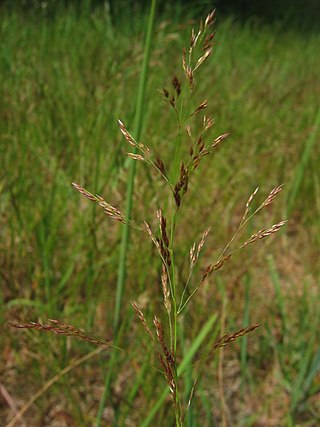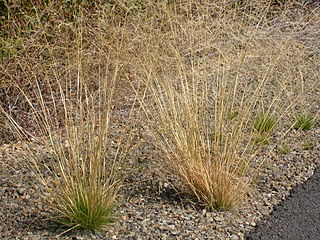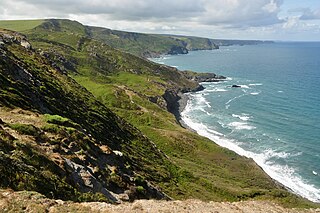
Agrostis is a large and very nearly cosmopolitan genus of plants in the grass family, found in nearly all the countries in the world. It has been bred as a GMO creeping bent grass.
NVC community H3 is one of the heath communities in the British National Vegetation Classification system. It is one of three communities which are considered transitional between the lowland dry heaths and the wetter communities classified in the NVC as mires.

Agrostis stolonifera is a perennial grass species in the family Poaceae. It is widely used as turf for golf courses.

St Boniface Down is a chalk down near Ventnor, on the Isle of Wight, England. Its summit, 241 metres (791 ft), is the highest point on the island, with views on a clear day stretching over 70 miles from Beachy Head to the east, Walbury Hill to the north, the Isle of Portland to the west and the French coast of Normandy to the south. It is 1 kilometre (0.6 mi) north of the town. There is reputed to be a wishing well on its southern slope, which requires the wisher to climb up from the south without looking back. In 1545, a French invasion force attempted this against a force of the Isle of Wight Militia commanded by Sir John Fyssher – which allegedly included several women archers- and were routed. In 1940, the radar station was bombed by Ju 87 Stuka dive bombers, which is reconstructed in the film "The Battle of Britain". The top is surmounted by a round barrow.
NVC community H2 is one of the heath communities in the British National Vegetation Classification system. It is one of five communities categorised as lowland dry heaths.

Lambert's Castle is an Iron Age hillfort in the county of Dorset in southwest England. Since 1981 it has been designated as a Site of Special Scientific Interest (SSSI) on account of its geology, archaeology and ecology. The hillfort is designated a scheduled monument together with a bowl barrow, the sites of a post-medieval fair and a telegraph station. The site was on the Heritage at Risk Register but was removed in 2022 as a result of the Hillforts and Habitats Project.
NVC community H4 is one of the heath communities in the British National Vegetation Classification system. It is one of three communities which are considered transitional between the lowland dry heaths and the wetter communities classified in the NVC as mires.
NVC community H5 is one of the heath communities in the British National Vegetation Classification system. It is one of three communities which are considered transitional between the lowland dry heaths and the wetter communities classified in the NVC as mires.
NVC community H6 is one of the heath communities in the British National Vegetation Classification system. It is one of five communities categorised as lowland dry heaths.

Agrostis capillaris, the common bent, colonial bent, or browntop, is a rhizomatous and stoloniferous perennial in the grass family (Poaceae). It is native to Eurasia and has been widely introduced in many parts of the world. Colonial bent grows in moist grasslands and open meadows, and can also be found in agricultural areas, roadsides, and invading disturbed areas.

Agrostis exarata is a species of grass known by the common names spike bentgrass, spike bent, Pacific bentgrass, and spike redtop. It is native to western North America from Texas to the Aleutian Islands.

Fire Beacon Hill is a Local Nature Reserve in East Devon, England. It is registered as Common land and known as Harpford Common. Sidmouth Town Council are the current owners, and are responsible for the management of the site.

Agrostis gigantea, known by its common names black bent and redtop, is a perennial grass of the Agrostis genus.

Agrostis scabra is a common species of grass known by the common names hair grass, rough bent, rough bent grass, winter bent grass, and ticklegrass. A tumbleweed, it is a bunchgrass native to Asia and much of North America, and widely known elsewhere as an introduced species.

Nardus is a genus of plants belonging to the grass family, containing the single species Nardus stricta, known as matgrass. It is placed in its own tribe Nardeae within the subfamily Pooideae. The name derives from ancient Greek nardos from the earlier Akkadian lardu. It is not to be confused with spikenard, Nardostachys jatamansi.

Agrostis canina, the velvety bentgrass, brown bent or velvet bent, is a species of grass in the family Poaceae.

Boscastle to Widemouth is a coastal Site of Special Scientific Interest (SSSI) in Cornwall, England, noted for its biological and geological characteristics. The Dizzard dwarf oak woodland is unique and of international importance for its lichen communities, with 131 species recorded.

Rosenannon Downs is a nature reserve in mid Cornwall, England, UK, being designated Rosenannon Bog and Downs Site of Special Scientific Interest (SSSI), noted for its biological characteristics. The site supports a wide variety of flora and fauna and includes Bronze Age barrows. Conservation work is carried out on the site by the owners, the Cornwall Wildlife Trust.
Acid grassland is a nutrient-poor habitat characterised by grassy tussocks and bare ground.

Agrostis castellana, the highland bent, dryland bent or dryland browntop, is a species of cool-season grass in the family Poaceae. It is native to Macaronesia and the Mediterranean, has been widely introduced elsewhere, and is considered an invasive species in some locales. It is a hyperaccumulator of zinc and lead.














